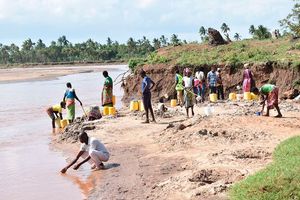Ministry moves in to contain bilharzia outbreak in Vihiga

Head of Kenya National Public Health Institute and Centres for Disease Control and Prevention Sultani Matendechero.
What you need to know:
- The acute and chronic disease is caused by parasitic flatworms.
- Infection occurs when skin comes in contact with contaminated freshwater in which certain types of snails that carry the parasite are living.
Health officers have intensified treatment for bilharzia in North East Bunyore, Vihiga County, after mass testing established over 20 per cent of the locals have contracted the infection.
North East Bunyore in Emuhaya has since been declared an endemic area, necessitating the move to upscale treatment and sensitisation.
The acute and chronic disease is caused by parasitic flatworms. Infection occurs when skin comes in contact with contaminated freshwater in which certain types of snails that carry the parasite are living.
Head of Kenya National Public Health Institute and Centres for Disease Control and Prevention Sultani Matendechero said the ongoing exercise is a joint effort of the national government, Amref and The End Fund.
Dr Matendechero, who led a team of medical officers to the area, said the health sector is determined to contain neglected tropical diseases that are becoming prevalent in rural areas.
He said massive bilharzia testing was undertaken in Vihiga, Kakamega, Busia and Trans Nzoia, with samples pointing to high prevalence in North East Bunyore. As a result, they are now focused on mass administration of drugs in the four counties and massive campaign and treatment in North East Bunyore.
“We first conducted epidemiological surveys where we tested samples of the populations within a community. When we find that 20 per cent are infected, we mark it as an endemic area,” said Dr Matendechero.
“We then intervene by giving all the people in the area mass treatment and then enhance campaign on safe water and basic sanitation. We discourage people from defaecating or urinating in water because that increases transmission.”
The medic noted that Kenya has taken the fight against neglected tropical diseases a notch higher at a time when the global level of endemicity is 20 per cent.
“For us (Kenya), we say anywhere we find worms, we treat to break transmission. We are deep into the village in Emuhaya, where we have observed community members receive these interventions.”
He said the Ministry of Health is keen to protect all citizens through urgent public health interventions.
Other than bilharzia, the ministry is also keen on fighting infections by intestinal worms such as the soil-transmitted helminthiasis. “Among the very important public interventions is the fight to eradicate bilharzia and intestinal worms,” said the official.
In December last year, the ministry revealed that 16 million people were at risk of contracting bilharzia and intestinal worms. This was after it undertook a burden assessment and mapping exercise.
The ministry said the people at risk were mainly from the western and coastal regions as most of them fail to observe simple public health measures that include use of toilets and proper hygiene through handwashing, for instance.
In the ongoing campaign, the public is being sensitised to the importance of proper use of toilets, disposal of human waste, handwashing and use of appropriate footwear.
Further, the Health ministry said it is working closely with the counties to establish water points to enhance hygiene and sanitation.





